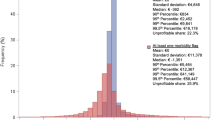Abstract
For an individual insurance firm offering supplementary private health insurance, a model is developed to decompose market performance in terms of insurer profits. For the individual contract, the model specifies the conditions under which adverse selection, cream skimming, and moral hazard occur, shows the impact of information on contracting, and the profit contribution. Contracts are determined by comparing willingness to pay for insurance with the individual’s risk position, and information on both sides of the market. Finally, performance is aggregated up to the total market. The model provides a framework to explain the attractiveness of supplementary markets to insurers.
Similar content being viewed by others
Explore related subjects
Discover the latest articles and news from researchers in related subjects, suggested using machine learning.References
Armstrong K., Weber B., Genevieve F.G., Hershey J.C., Pauly M.V., Lemaire J. et al (2003) Life insurance and breast cancer risk assessment: Adverse selection, genetic testing decisions, and discrimination. American Journal of Medical Genetics 120: 539–364 doi:10.1002/ajmg.a.20025
Cardon J.H., Hendel I. (2001) Asymmetric information in health insurance: Evidence from the National Medical Expenditure Survey. The Rand Journal of Economics 32(3): 408–427 doi:10.2307/2696362
Cawley J., Philipson T. (1999) An empirical examination of information barriers to trade insurance. The American Economic Review 89(4): 827–846
Cutler D.M., Zeckhauser R.J. (2000) The anatomy of health insurance. In: Culyer A.J., Newhouse J.P.(eds) Handbook of health economics Vol. Ia. Elsevier, Amsterdam, pp 563–643
Finkelstein A., McGarry K. (2006) Multiple dimensions for private information: Evidence from the long-term care insurance market. The American Economic Review 96(4): 938–958 doi:10.1257/aer.96.4.938
Godfried M., Oosterbeek H., van Tulder F. (2001) Adverse selection and the demand for supplementary dental insurance. De Economist 149(2): 177–190 doi:10.1023/A:1017566901875
Hoel M., Iversen T., Nilssen T., Vislie J. (2006) Genetic testing in competitive insurance markets with repulsion from chance: A welfare analysis. Journal of Health Economics 25: 847–860 doi:10.1016/j.jhealeco.2005.12.003
Leidl R. (2003) Medical progress and supplementary private health insurance. The Geneva Papers on Risk and Insurance. Issues and Practice 28(2): 222–237
Nelson D.E., Thompson B.L., Davenport N.J., Penaloza L.J. (2000) What people really know about their health insurance: A comparison of information obtained from individuals and their insurers. American Journal of Public Health 90(6): 924–928
Newhouse J.P. (1982) Is competition the answer?. Journal of Health Economics 1: 109–116 doi:10.1016/0167-6296(82)90023-6
Pauly M.V. (1968) The economics of moral hazard: Comment. American Economic Review 58(3): 531–537
Pauly M.V. (1984) Is cream-skimming a problem for the competitive medical market?. Journal of Health Economics 3: 87–95 doi:10.1016/0167-6296(84)90029-8
Rothschild M., Stiglitz J. (1976) Equilibrium in competitive insurance markets: An essay on the economics of imperfect information. The Quarterly Journal of Economics 90: 629–649 doi:10.2307/1885326
van de Ven W.P., van Vliet R.C. (1992) How can be prevent cream skimming in a competitive health insurance market. In: Zweifel P., Frech H.E.(eds) Health economics worldwide. Kluwer, Dordrecht, pp 23–46
van de Ven W.P., van Vliet R.C. (1995) Consumer information surplus and adverse selection in competitive health insurance markets: An empirical study. Journal of Health Economics 14(2): 149–169 doi:10.1016/0167-6296(94)00043-4
Author information
Authors and Affiliations
Corresponding author
Electronic Supplementary Material
The Below is the Electronic Supplementary Material.
Rights and permissions
About this article
Cite this article
Leidl, R. A model to decompose the performance of supplementary private health insurance markets. Int J Health Care Finance Econ 8, 193–208 (2008). https://doi.org/10.1007/s10754-008-9037-z
Received:
Accepted:
Published:
Issue Date:
DOI: https://doi.org/10.1007/s10754-008-9037-z




